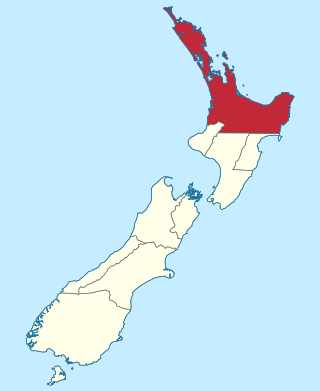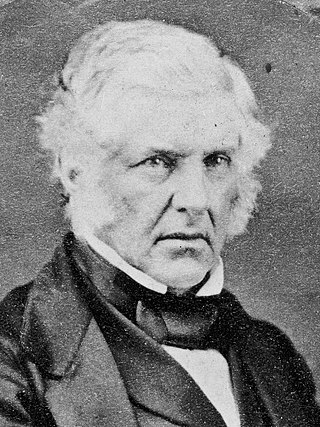Related Research Articles
The First Taranaki War was an armed conflict over land ownership and sovereignty that took place between Māori and the Colony of New Zealand in the Taranaki region of New Zealand's North Island from March 1860 to March 1861.

Sir Harry Albert Atkinson served as the tenth premier of New Zealand on four separate occasions in the late 19th century, and was Colonial Treasurer for a total of ten years. He was responsible for guiding the country during a time of economic depression, and was known as a cautious and prudent manager of government finances, though distrusted for some policies such as his 1882 National Insurance (welfare) scheme and leasehold land schemes. He also participated in the formation of voluntary military units to fight in the New Zealand Wars, and was noted for his strong belief in the need for seizure of Māori land.

Inglewood is a town in the Taranaki Region of New Zealand's North Island. It is 16 kilometres (10 mi) southeast of New Plymouth on State Highway 3, close to Mount Taranaki, and sits 200 metres (660 ft) above sea level. The town services a mainly dairy farming region.
The 2nd New Zealand Parliament was a term of the Parliament of New Zealand. It opened on 15 April 1856, following New Zealand's 1855 election. It was dissolved on 5 November 1860 in preparation for 1860–61 election. The 2nd Parliament was the first under which New Zealand had responsible government, meaning that unlike previously, the Cabinet was chosen by Parliament rather than by the Governor-General of New Zealand.
Charles Brown was a New Zealand politician from the Taranaki area.

The Auckland Province was a province of New Zealand from 1853 until the abolition of provincial government in 1876.

New Plymouth is a New Zealand parliamentary electorate. It was first created for the 1st New Zealand Parliament in 1853 and has existed since, with one 32-year interruption. The electorate was initially called Town of New Plymouth.

Ōakura is a small township in New Plymouth District, Taranaki, in the western North Island of New Zealand. It is located on State Highway 45, 15 kilometres south-west of New Plymouth. Ōkato is 12 km further south-west. The Oakura River flows past the town and into the North Taranaki Bight. To the south is the Kaitake Range, part of Egmont National Park.

Mangorei is a locality on the outskirts of New Plymouth in Taranaki, New Zealand. The city centre is about 5 km (3.1 mi) to the north-west. State Highway 3 passes to the south-west.
Omata was a New Zealand electorate. It was located in Taranaki and based on the township of Omata. One of the original 24 electorates, it existed from 1853 to 1870.

Charles Emanuel Bellringer (1864–1944) was a Reform Party Member of Parliament, serving one three-year term. He unsuccessfully stood in general elections five times, the first three of those for the Liberal Party. He lived his whole life in New Plymouth and was involved with many organisations, most notably as chairman of the New Plymouth Harbour Board, as a prohibitionist, and one of the co-founders of the Methodist Church of New Zealand. He took over his father's company and was its executive director.
Waimea was a parliamentary electorate in the Nelson Province of New Zealand, from 1853 to 1887. Initially represented by two members, it was a single-member electorate from 1861.

Henry Brown JP was an independent conservative Member of Parliament in New Zealand. He was a prominent saw miller in the Taranaki Region.
The 3rd New Zealand Parliament was a term of the Parliament of New Zealand. Elections for this term were held between 12 December 1860 and 28 March 1861 in 43 electorates to elect 53 MPs. Two electorates were added to this during this term, Gold Fields District and a new Dunedin electorate created by splitting the existing City of Dunedin into Dunedin and Suburbs North and Dunedin and Suburbs South, increasing the number of MPs to 57. During the term of this Parliament, six Ministries were in power.

Thomas King was a 19th-century New Zealand politician. He served in the 1st and 2nd Parliaments, and was otherwise active in New Plymouth. He was one of the first settlers, coming out on the first ship to New Plymouth in 1841.
Henry Bunny was a 19th-century Member of Parliament in the Wairarapa, New Zealand.

The 1865 Town of New Plymouth by-election was a by-election held in the Town of New Plymouth electorate during the 3rd New Zealand Parliament, on 19 May 1865. The by-election was caused by the resignation of the incumbent, Charles Brown, and was won unopposed by Henry Sewell. Whilst Sewell was not a local resident, he was a member of the government through his appointment to the Legislative Council, the upper house of Parliament. Sewell accepted the invitation to represent the electorate, as him becoming a member of the lower house was seen to strengthen the government.
The 1867 Town of New Plymouth by-election was a by-election held on 29 April 1867 in the Town of New Plymouth electorate during the 4th New Zealand Parliament.
The 1869 Town of New Plymouth by-election was a by-election held on 28 April 1869 in the Town of New Plymouth electorate during the 4th New Zealand Parliament.

Bell Block is a town in Taranaki, New Zealand. State Highway 3 runs through it. It is 6 km north-east of the centre of New Plymouth and 1 km from the outer edge of New Plymouth at Waiwhakaiho. Waitara is about 9 km to the north-east. New Plymouth Airport is located immediately to the north-east of Bell Block.
References
- ↑ Wilson, James Oakley (1985) [First ed. published 1913]. New Zealand Parliamentary Record, 1840–1984 (4th ed.). Wellington: V.R. Ward, Govt. Printer. p. 241. OCLC 154283103.
- ↑ "Election". Taranaki Herald. 19 November 1864.